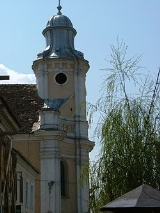
Transfiguration Cathedral, Cluj-Napoca
Encyclopedia
The Transfiguration Cathedral , also known as the Minorites' Church (Biserica Minoriţilor), was donated in 1924 by the Holy See to the Romanian Greek-Catholic Church
to serve as the Cathedral of the Cluj-Gherla Eparchy, after the move of the Eparchy's center from Gherla
to Cluj
.
. The design was made by the architect of the Bánffy Palace, Johann Eberhard Blaumann. The tower and the roof of the church burnt down in 1798, and a temporary wooden roof was constructed. The new roof was built only in the 19th century. The murals of the ceiling were painted by Ferenc Lohr in 1908.
Several families offered mass stipends to support the construction of the church. Many of them were later entombed in the church's crypt until 1834, when burials within the city walls were forbidden due to a cholera epidemic. Seven Baroque and Empire style honorary monuments, mostly of wealthy Armenian families, can be found in the church.
In 1924 Pope Pius IX
gave the church to the Greek-Catholic Church
to serve as the cathedral of the Cluj-Gherla Eparchy. When the Greek-Catholic Church was dissolved in 1948 by the Communist regime, the church was given to the Romanian Orthodox Church
.
After the decline of Communism (1989) the Greek-Catholic Church asked for the restitution of the building, but they were refused. After a long litigiation process on 20 February 1998 the Court of Ploieşti
decided in the favour of the Greek Catholic Church. On 20 March 1500 ortodox priests held a procession in the centre of Cluj to protest again the restitution.
Romanian Church United with Rome, Greek-Catholic
The Romanian Church United with Rome, Greek-Catholic is an Eastern Catholic Church which is in full union with the Roman Catholic Church. It is ranked as a Major Archiepiscopal Church and uses the Byzantine liturgical rite in the Romanian language....
to serve as the Cathedral of the Cluj-Gherla Eparchy, after the move of the Eparchy's center from Gherla
Gherla
Gherla is a city in Cluj County, Romania . It is located 45 km from Cluj-Napoca on the Someşul Mic River, and has a population of 24,083....
to Cluj
Cluj-Napoca
Cluj-Napoca , commonly known as Cluj, is the fourth most populous city in Romania and the seat of Cluj County in the northwestern part of the country. Geographically, it is roughly equidistant from Bucharest , Budapest and Belgrade...
.
History
The first church of the Minorites in Cluj was the building known today under the name Farkas Street Reformed Church. In 1556 the Minorite order was expelled out of the city. They were permitted to come back only in 1724 and could settle down only outside the city walls. Around 1765 the city council gave permission to the monks to settle down within the city walls. The church and the monastery were built in 1778-79, but the tower collapsed on 24 September 1779 due to mistakes made at the basement works. The re-building of the tower was financed by the empress Maria Theresa of AustriaMaria Theresa of Austria
Maria Theresa Walburga Amalia Christina was the only female ruler of the Habsburg dominions and the last of the House of Habsburg. She was the sovereign of Austria, Hungary, Croatia, Bohemia, Mantua, Milan, Lodomeria and Galicia, the Austrian Netherlands and Parma...
. The design was made by the architect of the Bánffy Palace, Johann Eberhard Blaumann. The tower and the roof of the church burnt down in 1798, and a temporary wooden roof was constructed. The new roof was built only in the 19th century. The murals of the ceiling were painted by Ferenc Lohr in 1908.
Several families offered mass stipends to support the construction of the church. Many of them were later entombed in the church's crypt until 1834, when burials within the city walls were forbidden due to a cholera epidemic. Seven Baroque and Empire style honorary monuments, mostly of wealthy Armenian families, can be found in the church.
In 1924 Pope Pius IX
Pope Pius IX
Blessed Pope Pius IX , born Giovanni Maria Mastai-Ferretti, was the longest-reigning elected Pope in the history of the Catholic Church, serving from 16 June 1846 until his death, a period of nearly 32 years. During his pontificate, he convened the First Vatican Council in 1869, which decreed papal...
gave the church to the Greek-Catholic Church
Romanian Church United with Rome, Greek-Catholic
The Romanian Church United with Rome, Greek-Catholic is an Eastern Catholic Church which is in full union with the Roman Catholic Church. It is ranked as a Major Archiepiscopal Church and uses the Byzantine liturgical rite in the Romanian language....
to serve as the cathedral of the Cluj-Gherla Eparchy. When the Greek-Catholic Church was dissolved in 1948 by the Communist regime, the church was given to the Romanian Orthodox Church
Romanian Orthodox Church
The Romanian Orthodox Church is an autocephalous Eastern Orthodox church. It is in full communion with other Eastern Orthodox churches, and is ranked seventh in order of precedence. The Primate of the church has the title of Patriarch...
.
After the decline of Communism (1989) the Greek-Catholic Church asked for the restitution of the building, but they were refused. After a long litigiation process on 20 February 1998 the Court of Ploieşti
Ploiesti
Ploiești is the county seat of Prahova County and lies in the historical region of Wallachia in Romania. The city is located north of Bucharest....
decided in the favour of the Greek Catholic Church. On 20 March 1500 ortodox priests held a procession in the centre of Cluj to protest again the restitution.

